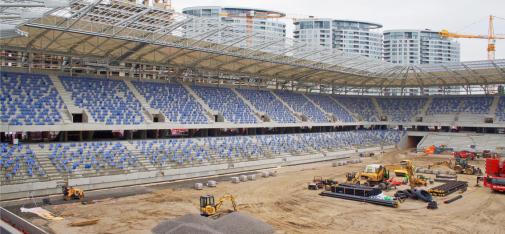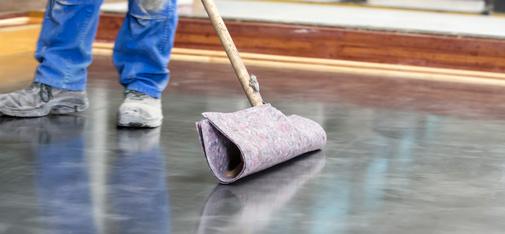-

Ortolan for reliable concrete stripping
During the construction of the new Gateway Gardens stop in Frankfurt, the exposed concrete walls of the tunnel and the metro station exhibit an immaculate fair-faced finish by using the MC concrete release agent Ortolan Basic 761.
Ortolan for reliable concrete stripping
Frankfurt - Deutschland
On the outskirts of Frankfurt am Main, a new railway line is currently being built between the airport station and the “Stadion” (stadium) station to connect the Gateway Gardens development area. A double-track tunnel is also being constructed, adjoined by the new underground “S-Bahn” (metropolitan railway) station serving Gateway Gardens. Thanks to the release agent Ortolan Basic 761, the exposed concrete walls of both the tunnel and the metro station exhibit an immaculate fair-faced finish.
In addition to the construction of the new Gateway Gardens stop, the planned S-Bahn connection includes the relocation of the S-Bahn line between Frankfurt Stadium and Frankfurt Airport Regional Station. Around two kilometres of the new line run underground in a double-track tunnel, most of which will be constructed using the cut-and-cover method. The client, German railway operator Deutsche Bahn, commissioned Wayss & Freytag Ingenieurbau AG of Düsseldorf with this major construction project valued at an estimated 223 million euros. The civil engineering work began in 2016.
Challenging concrete works
The tunnel has since been built in the form of a rectangular frame structure made of various concrete components cast on site, requiring wall thicknesses of up to 180 cm.

© MC-Bauchemie 2025
With these dimensions, it is not just the high level of heat development due to hydration that constitutes a significant challenge; also the fitting of the walls with large quantities of structural steel and the small clearances available for vibrating the concrete can give rise to major porosities and shrinkage cavities. This problem is particularly acute in the area of the new underground S-Bahn station, where exposed concrete class SB 3 is required.
The right concrete release agent
Given the size of the concrete components required, cement containing granulated slag was used in their production. It sets more slowly, develops less hydration heat and reduces early cracking in the concrete. The disadvantage: The freshly demoulded or stripped concrete surface can temporarily develop a greenish-blue tinge. However, the release agent used can have a significant impact in this regard. Its effect on the colour of the concrete is an aspect that is frequently underestimated. Extensive preliminary tests had to be carried out in order to determine which release agent would guarantee an unadulterated concrete grey finish after stripping. Ortolan Basic 761 was the only concrete release agent able to consistently convince in terms of quality during these trials: While the blue colour caused by other products actually changed to darker tones and even to black after stripping, Ortolan did not produce any discoloration once hydration had been completed.
Ortolan separates, preserves and protects
Ortolan Basic 761 is a high-quality concrete release agent from MC with a universal performance profile. It is robust enough for the construction site and has been successfully tested for all types of formwork. It preserves and protects steel formwork yet also prevents swelling, warping and the drying-out of timber formwork. Its very good release and separating effect in summer and winter also ensured that the concrete in the Frankfurt project had an impressively attractive fair-faced finish. Ortolan Basic 761 also scores high in terms of its harmlessness to users and the environment alike: It is classed as a non-hazardous substance, corresponds to the water hazard class WHC 1, and is quickly biodegradable with a degradation rate > 99 % after 28 days. It is particularly easy to spray and economical in dosage and use. The section with the new station is to go into operation for the timetable change on 15 December 2019 so as to relieve the load on the surrounding roads.
-
Name
Ortolan for reliable concrete stripping
-
Country
Frankfurt - Deutschland, 2019
-
Fields of Expertise
-
Categories
-
Products
RELATED CONTENT
-
News
Click here to go to our News section.
-
MC-Pedia
In our MC-Pedia you will find technical articles on various topics written exclusively by our specialists.
-
Magazine
Get our latest issues of our customer and employee magazine MC aktiv.
-
Downloads
Find all relevant datasheets of our products as well as brochures of our company, Fields of Expertise and product categories here.
-
References
Click here to get to our library with reference projects for all types of application.
-
Careers
Click here to go to MC Career.
-
Contact
Click here to go to our Contact section.


